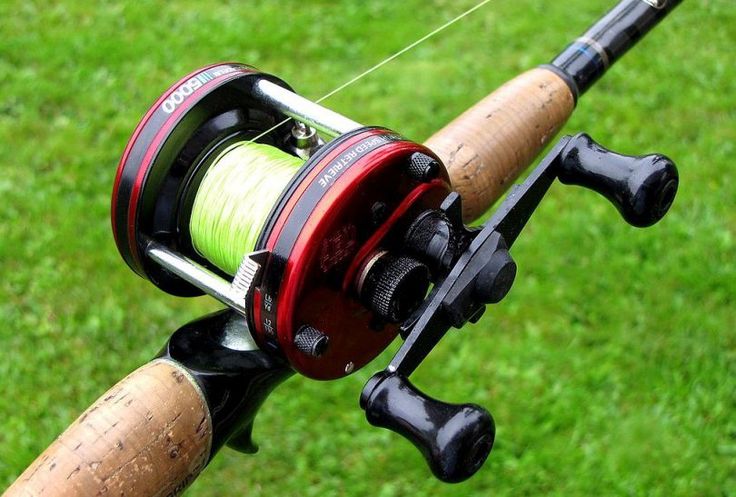When it comes to fishing, the type of reel you use plays a crucial role in determining the success of your fishing trip. Fishing reels are mechanical devices attached to fishing rods, designed to deploy and retrieve fishing lines smoothly. While all fishing reels perform the same basic function, they vary significantly in terms of features, complexity, and suitability for different fishing styles and environments. This article will explore the most common types of fishing reels, discussing their characteristics, pros and cons, and best uses.
Spincast Reels
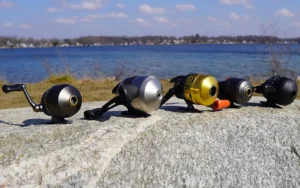
Spincast reels, also known as closed-face reels, are among the easiest types of fishing reels to use, making them a favorite for beginners and casual anglers. The reel is mounted on top of the fishing rod and features a metal or plastic cover that encloses the spool of the fishing line.
How It Works: The spin cast reel uses a button release system. Pressing the button allows the line to be cast, and releasing it stops the line. The line is retrieved using a handle that rotates the spool.
Best For: Beginners, children, and casual anglers.
Pros:
- Simple and easy to use.
- Affordable and great for teaching kids how to fish.
- Minimal chances of line tangling or backlash.
Cons:
- Limited casting distance compared to other reels.
- Not suitable for large fish or long-distance casting.
Best Uses: Spincast reels are ideal for light fishing in ponds, lakes, or rivers, targeting smaller species like bluegill, crappie, and trout.
Spinning Reels
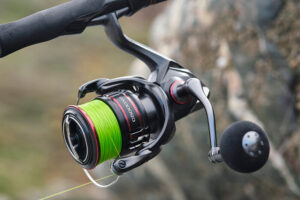
Spinning reels, or open-face reels, are one of the most popular types of reels due to their versatility and ease of use. These reels are mounted underneath the rod and feature a fixed spool, which allows the line to flow freely during casting.
How It Works: Spinning reels use a bail arm mechanism to control the line. The bail is opened to cast the line, and when the handle is turned, the bail closes and the line is retrieved by winding it around the spool.
Best For: Anglers of all skill levels, from beginners to seasoned fishermen.
Pros:
- Great casting distance and accuracy.
- Versatile and suitable for both light and heavy lines.
- Works well with a variety of lures and bait.
Cons:
- Prone to line twists, which can affect casting performance.
- Not as powerful as baitcasting reels for targeting large fish.
Best Uses: Spinning reels are highly versatile and can be used in both freshwater and saltwater environments. They are ideal for targeting a wide range of species, from bass and trout in freshwater to redfish and snook in saltwater.
Baitcasting Reels

Baitcasting reels, also known simply as casting reels, are designed for more advanced anglers who are looking for better control and power. These reels are mounted on top of the rod and have a rotating spool, allowing for greater accuracy and control when casting heavier lures or targeting larger fish.
How It Works: With baitcasting reels, the spool rotates as the line is released. The angler controls the speed and distance of the cast by using their thumb to apply pressure on the spool. This requires more skill to avoid backlashes, where the line tangles as it comes off the spool too quickly.
Best For: Experienced anglers who prioritize precision and power.
Pros:
- Greater casting accuracy and control.
- Stronger drag system, making it ideal for fighting large fish.
- Suitable for heavy lines and larger lures.
Cons:
- Learning curve due to the potential for backlash.
- More expensive than spincast or spinning reels.
Best Uses: Baitcasting reels are often used in freshwater and saltwater fishing when targeting larger species such as bass, pike, catfish, and muskie. They are also a top choice for anglers fishing in heavy cover or using techniques like flipping and pitching.
Fly Reels
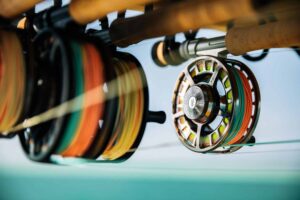
Fly reels are a specialized type of fishing reel designed for fly fishing. Unlike other reels, fly reels are simple in design and rely on manual operation rather than a mechanical drag system. The goal in fly fishing is to cast a lightweight fly (bait) using a heavier fly line, and the reel’s role is primarily to store the line and provide resistance during retrieval.
How It Works: Fly reels typically have a simple spool and handle, and the angler must manually pull the line off the reel when casting. The drag system, if present, provides tension to slow down the fish during a fight.
Best For: Fly fishing enthusiasts, usually more experienced anglers.
Pros:
- Minimalistic design, easy to maintain.
- Precision control when retrieving line during a fight with fish.
- Designed for the unique demands of fly fishing.
Cons:
- Limited to fly fishing; not versatile for other types of angling.
- Requires skill to master casting and line control.
Best Uses: Fly reels are used exclusively for fly fishing, typically in rivers, streams, and lakes. They are ideal for catching species like trout, salmon, and grayling.
Trolling Reels
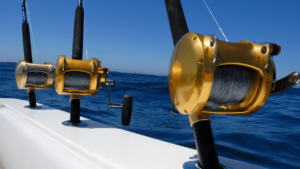
Trolling reels, also known as conventional reels, are designed for a specific type of fishing where the line is dragged (trolled) behind a moving boat. These reels are heavy-duty and built for targeting large fish in deep waters, both in freshwater and saltwater environments.
How It Works: Trolling reels have a robust design with a high-capacity spool that allows for a significant amount of line to be deployed. They often feature a lever drag system for smooth line control and easy adjustment of the drag while battling large fish.
Best For: Anglers targeting large species in deep waters, especially offshore fishing.
Pros:
- High line capacity and strong drag system.
- Designed for targeting big game fish.
- Excellent for deep-sea or trolling techniques.
Cons:
- Bulky and heavy compared to other reels.
- Not versatile; primarily designed for trolling.
Best Uses: Trolling reels are perfect for deep-sea fishing and targeting large species such as marlin, tuna, sailfish, and kingfish. They are commonly used in saltwater but can also be effective for lake fishing for large species like lake trout or muskies.
Surf Fishing Reels
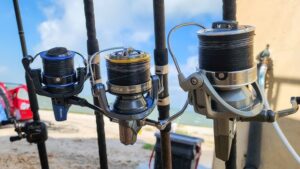
Surf fishing reels are specialized spinning or conventional reels designed for surf fishing, where anglers cast from the shoreline into the ocean. These reels are built to handle long casts, heavy lines, and the tough conditions of saltwater fishing.
How It Works: Surf reels are designed with large spools to accommodate long casting distances and have corrosion-resistant materials to withstand saltwater exposure. They often feature a robust drag system for controlling large fish in strong surf conditions.
Best For: Surf anglers who fish from shorelines and need long-distance casting ability.
Pros:
- Built for long casting distances.
- Durable and resistant to saltwater corrosion.
- Powerful drag system for handling large fish.
Cons:
- Bulky and often heavier than standard reels.
- Not suitable for freshwater or light tackle fishing.
Best Uses: Surf fishing reels are ideal for targeting species like striped bass, redfish, and bluefish from the shore. They are best suited for beach or pier fishing and can handle the challenges of rough surf conditions.
Conclusion
Choosing the right fishing reel depends on your experience level, fishing style, and the species you’re targeting. Beginners may prefer spin cast or spinning reels for their ease of use, while more experienced anglers might opt for baitcasting reels for their precision and control. Fly reels are best suited for the specific needs of fly fishing, and trolling reels offer the strength required for deep-sea adventures.
By understanding the different types of fishing reels and their best applications, you can make informed decisions and enhance your overall fishing experience.

